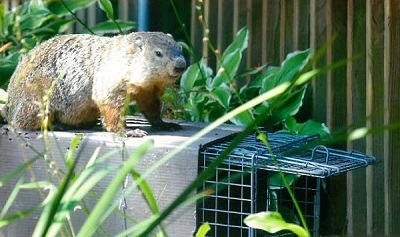You see woodchuck (groundhog) heads popping up in fields, and then quickly, they disappear. You may even see them hurrying across the street from time to time, avoiding traffic. Groundhogs are crepuscular. They are most active in the mornings late afternoons and evenings. They’ll retreat to their burrows during the hottest parts of the day.

Woodchucks are attracted to food sources in your yard and garden. They primarily feed on grasses, clover, dandelions, and other native plants. Gardens are particularly enticing to woodchucks as they enjoy fruits and vegetables such as lettuce, beans, peas, and berries, and they will even nibble on ornamental plants and flowers. Compost piles and fallen fruits beneath trees also appeal to these animals, providing easy access to food in residential areas.
When you see them, they are out and about, searching for food to take back to their underground home. Woodchucks prefer to make a home under a shed, barn, or even your house. They dig multiple tunnels, giving them access to their underground den at several locations.
Damage Caused by Woodchucks
The problem is that the tunnels destroy the foundation of your house, shed, or other structure. Groundhogs can move hundreds of pounds of dirt when they are burrowing. Depending on your type of foundation, your home could be sitting on uneven ground. You will know it soon enough because your foundation will shift and cracks will form. Eventually, your house may fall.
Groundhogs also wreak havoc on your garden. They create large holes in fields, causing severe damage to tractors and farm equipment. If horses or livestock step in a groundhog hole, it can be a costly vet bill.
What are some humane ways to get rid of woodchucks?
Some people claim Epsom salt on your plants can deter a woodchuck from entering your garden, but I haven’t heard of that work.
Taste repellents like mint and capsaicin do work. Taste repellents like capsaicin do work. You can spray the repellent on leaves but don’t spray on food crops. Apply every 30-60 days depending on rain. They are not 100% effective. An important caveat for repellents. If an animal really wants to be somewhere, it will get there. If the animal has young, maternity instinct will override a repellent.
If that doesn’t work, you might be able to live trap and relocate groundhogs. You need to check local and state laws before you attempt to relocate any wildlife.
Fences make great neighbors. Trapping a groundhog can be labor intensive. A fence around your garden can keep groundhogs from eating your vegetables and flowers.
Be aware of the birth season. In New Hampshire, groundhogs breed in Late March and April after hibernating. They give birth in April, and the young can leave the burrow in June. So if you trap and relocate a lactating mother in May, the young will be abandoned in the burrow.